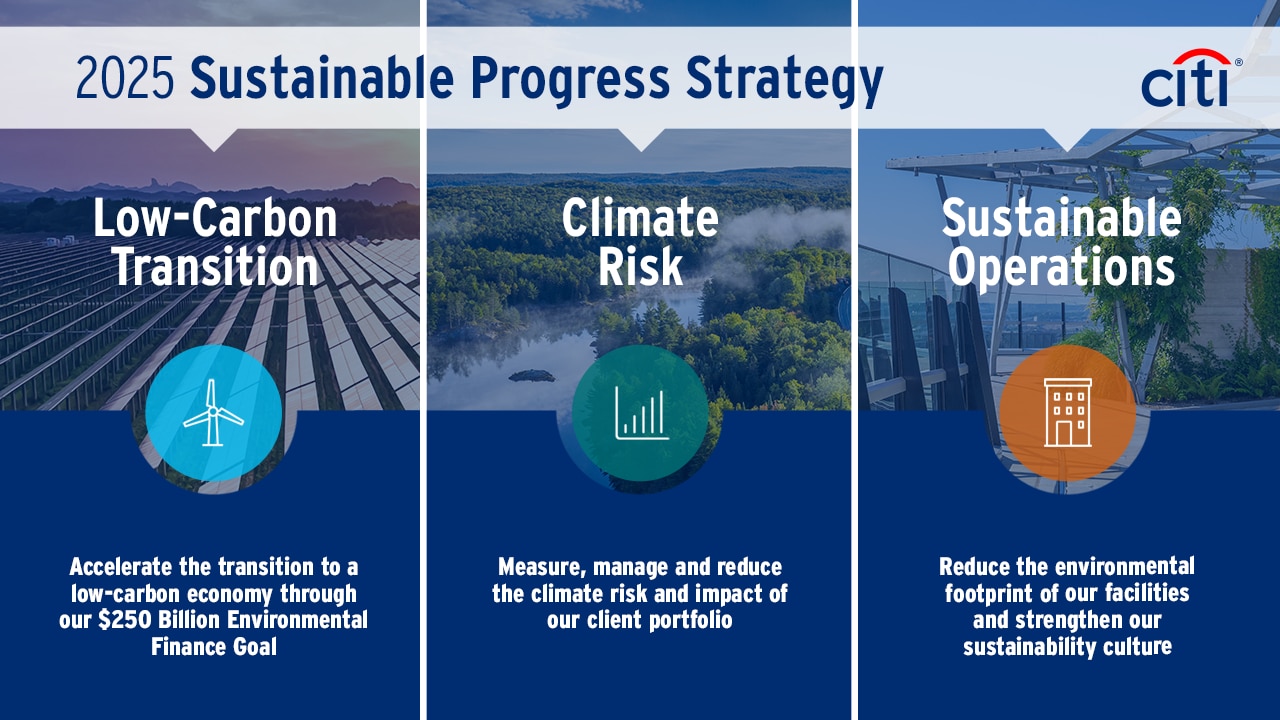Building Towards a Sustainable Future
Over the past few months, in the midst of our global health crisis, some have questioned the connection between sustainability and the broader issues weighing on our society. But if we take one lesson away from these intersecting crises, as our CEO Mike Corbat has said – it is that our physical and economic health, our sustainability and resiliency, and social justice are inextricably linked.
As communities begin to look to their recoveries and aim to rebuild, we see the parallels between COVID-19 and the longer-term climate crisis. We know the cost and disruption of managing the crisis will only increase the longer we delay, and that collective action is needed to address climate change head on. Even under current restraints, we recognize the need to accelerate the transition to a low-carbon economy.
Today, Citi is launching our new 2025 Sustainable Progress Strategy rooted in this broader environmental and societal context. It builds on Citi's 20+ year sustainability track record and leadership in sustainable finance, and the $164 billion in environmental finance we supported between 2014 and 2019. At the core of our new strategy is a $250 Billion Environmental Finance Goal, representing a commitment two-and-a-half times larger than its predecessor, which we aim to achieve in half the time. That accelerated pace reflects the urgency we need to advance, as a company and a society, to help beat back the tide of climate change.
Over the next five years, our ambition is to be the world's leading bank in driving the transition to a low-carbon economy by focusing on three key pillars of activity – financing climate solutions, deepening climate risk assessment and disclosure, and reducing the environmental impacts of our operations.
Toward our new $250 billion goal, we are financing and facilitating activities in renewable energy, clean technology, water quality and conservation, sustainable transportation, green buildings and energy efficiency. We also added circular economy and sustainable agriculture and land use as two new areas under this goal, as the production of materials, food and the management of land reflect major sources of emissions. We will also continue to focus on helping our clients across all sectors, no matter where they are in their own sustainability journeys, to transition to more sustainable business models and practices that will advance our progress towards a low-carbon economy.
Our new strategy is also premised on the fact that while the scale of the opportunity is vast, climate-associated risks will also increase. Measuring, managing and reducing the climate risk and impact of our client portfolio will also be central to our ability to help drive the low-carbon transition, and we are joining the Partnership for Carbon Accounting Financials (PCAF) to support these efforts. As a leader in climate assessment and disclosure in alignment with the Task Force on Climate-related Financial Disclosures (TCFD) Recommendations, we released our first comprehensive TCFD report two years ago. We will continue to expand on this work and focus on building a more reliable toolbox for climate risk assessment that allows us to more accurately measure and manage our climate change impacts and opportunities.
This will also allow us to have more informed conversations and engagement with not only our clients on their climate risk management, but also with regulators, advocacy groups and our peers on multi-stakeholder efforts to share learnings and best practices. We'll continue to disclose and analyze our results, which is key to our success and our ability to drive innovative and collaborative solutions.
We also recognize that ensuring our own house is in order is fundamental to our credibility and ability to meaningfully engage with clients and other stakeholders. We are continuing to reduce our own operational footprint with our fourth generation of goals to cut emissions, waste and water usage. We are on a path to achieving our goal of sourcing 100% renewable electricity for our own facilities globally before the end of this year. In April, the U.S. Green Building Council reaffirmed our approach by awarding our global headquarters in New York its highest LEED (Leadership in Energy and Environmental Design) Platinum rating, in recognition of its sustainability features.
We are rolling out this new strategy today because now more than ever, global financial institutions like Citi have the opportunity – and the responsibility – to play a leading role as catalysts for the coming recovery. The challenges ahead of us are immense – to help drive the low-carbon transition of our global economy, and make good on the promise of the Paris Agreement. And while our businesses are integrated into local economies around the world, we can't do it alone – we'll need to join efforts with governments, clients and competitors. We are calling on our fellow companies and organizations in the public and private sectors to join us in committing to the "Decade of Action" that will challenge us all to take concrete steps to drive meaningful climate solutions and work together to build a more sustainable future.
For more information on our 2025 Sustainable Progress Strategy, visit https://uat.citigroup.com/global/our-impact/sustainability .
